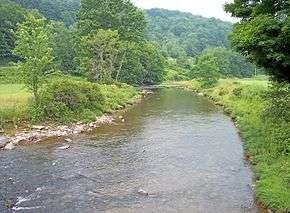Glady Fork
Glady Fork is a 31.9-mile-long (51.3 km)[4] river in the Allegheny Mountains of eastern West Virginia, USA. It is considered one of the five principal headwaters tributaries of the Cheat River — known as the Forks of Cheat.
| Glady Fork | |
|---|---|
 The Glady Fork in Randolph County in 2006 | |
| Location | |
| Country | United States |
| State | West Virginia |
| Counties | Randolph, Tucker |
| Physical characteristics | |
| Source | West Fork Glady Fork |
| • location | Lynn Divide, Randolph County |
| • coordinates | 38°44′08″N 79°45′56″W |
| • elevation | 3,154 ft (961 m)[1] |
| 2nd source | East Fork Glady Fork |
| • location | Middle Mountain, Randolph County, WV |
| • coordinates | 38°42′48″N 79°44′05″W |
| • elevation | 3,707 ft (1,130 m)[2] |
| Source confluence | |
| • location | Glady, WV |
| • coordinates | 38°48′03″N 79°43′07″W |
| • elevation | 2,841 ft (866 m) |
| Mouth | Dry Fork[3] |
• location | Gladwin, WV |
• coordinates | 39°00′33″N 79°32′48″W |
• elevation | 1,946 ft (593 m)[3] |
| Length | 32 mi (51 km)[4] |
| Basin size | 64 sq mi (170 km2)[5] |
Geography
The Glady Fork is a tributary of the Dry Fork; via the Dry Fork, the Black Fork, and the Cheat, Monongahela and Ohio rivers, it is part of the watershed of the Mississippi River, draining an area of 64 square miles (170 km2) in the Allegheny Mountains. With the Dry Fork, the Laurel Fork, the Shavers Fork and the Blackwater River, it is considered one of the five principal headwaters tributaries of the Cheat.[6] The stream was named for the presence of glades along the river.[7]
The Glady Fork is formed at the community of Glady in Randolph County by the confluence of two short northward-flowing streams known as East Fork Glady Fork[8] and West Fork Glady Fork;[9] the forks flow from a ridge known as Lynn Divide[10] which separates the Cheat River watershed in Randolph County from the Greenbrier River watershed in Pocahontas County. From the confluence the Glady Fork flows north-northeastwardly in a meandering course between Middle Mountain and Shavers Mountain in the Monongahela National Forest, through eastern Randolph County into southern Tucker County, where it joins the Dry Fork at the community of Gladwin.[11]
According to the West Virginia Department of Environmental Protection, nearly 94% of the Glady Fork's watershed is forested, mostly deciduous.[5] The lower half of the river's course is characterized by continuous Class 2 rapids, with Class 3 whitewater in the lowermost three-to-four miles (5–6 km).[12]
See also
- List of West Virginia rivers
References
- "West Fork Glady Fork Source". Elevation Query. U.S. Geological Survey. Retrieved 2008-09-13.
- "East Fork Glady Fork Source". Elevation Query. U.S. Geological Survey. Retrieved 2008-09-13.
- "Glady Fork". Geographic Names Information System. United States Geological Survey. Retrieved 2008-09-13.
- U.S. Geological Survey. National Hydrography Dataset high-resolution flowline data. The National Map Archived 2012-04-05 at WebCite, accessed August 15, 2011
- West Virginia Department of Environmental Protection. "Watershed Atlas Project". pp. Cheat River. Archived from the original on 2000-08-17. Retrieved 2007-02-02.
- Julian, Norman. 2006. "Cheat River." The West Virginia Encyclopedia. Ken Sullivan, editor. Charleston, WV: West Virginia Humanities Council. ISBN 0-9778498-0-5.
- Kenny, Hamill (1945). West Virginia Place Names: Their Origin and Meaning, Including the Nomenclature of the Streams and Mountains. Piedmont, West Virginia: The Place Name Press. p. 271.
- "East Fork Glady Fork". Geographic Names Information System. United States Geological Survey. Retrieved 2008-09-13.
- "West Fork Glady Fork". Geographic Names Information System. United States Geological Survey. Retrieved 2008-09-13.
- "Geographic Names Information System entry for Lynn Divide (Feature ID #1551972)". Retrieved 2007-02-02.
- DeLorme (1997). West Virginia Atlas & Gazetteer. Yarmouth, Maine: DeLorme. pp. 37-38, 47. ISBN 0-89933-246-3.
- Davidson, Paul; Ward Eister; Dirk Davidson; Charlie Walbridge (1995). Wildwater West Virginia (4th ed.). Birmingham, Ala.: Menasha Ridge Press. pp. 85. ISBN 0-89732-156-1.